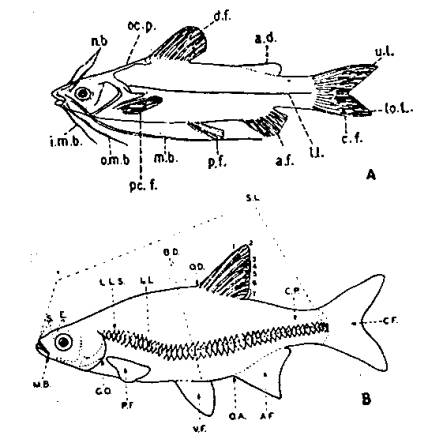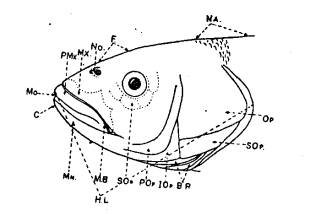
Methodology

IDENTIFICATION OF FISHES
II IDENTIFICATION OF FISHES
Scientific identification of fishes is based mainly on external characters such as body shape, length, depth, mouth and nature of fish spines, scales, etc. The best way to collect fish for a scientific or taxonomic study is to catch them alive through a fishing net, trap or any other device locally adopted except poisoning with toxic chemicals.

Fig 1:
Outline lateral view diagrams of A) a non-scaled catfish and B) a scaled fish
showing body parts
|
A. Non-scaled catfish |
B. Scaled fish |
|
a.d.
= adipose dorsal fin |
A.F.
= anal fin |
|
a.f.
= anal fin |
B.D.
= body depth |
|
c.f.
= caudal fin |
C.F.
= caudal fin |
|
d.f.
= dorsal fin |
C.P.
= caudal peduncle |
|
i.m.b.
= inner mandibular barbell |
E. =
length of eye |
|
l.l.
= lateral line |
G.O.
= gill opening |
|
lo.
l. = lower lobe of caudal fin |
L.L.
= lateral line |
|
m.b.
= maxillary barbell |
L.L.S.
= lateral line scales |
|
n.b.
= nasal barbell |
M.B.
= maxillary barbell (in terminal position) |
|
oc.p.
= occipital process |
O.A.
= origin of anal fin |
|
o.m.b.
= outer mandibular barbell |
O.D.
= origin of dorsal fin |
|
p.f.
= pelvic fin |
P.F.
= pectoral fin |
|
pc.f.
= pectoral fin |
S. =
length of snout |
|
u.l.
= upper lobe of caudal fin |
S.L.
= standard length |
|
|
V.F.
= pelvic fin |
|
|
1 to
7, dorsal fin rays (note that two very small rays at the front end of this
fin are not counted and that the last fin ray is divided to its base |
Fish have different ecological preferences and inhabit waters best suited to them. Environmental factors influence the predominance of certain species of fish. For instance, river fishes prefer riffle or quiet areas; a hill stream with fast flowing water over rocky bed may not have large sized carps, while dimly lit, shallow swampy pools may have cat fishes, mussels, eels and may not have fishes like rohu, mrigal etc.
The fishes caught are segregated mainly based on the presence or absence of scales on the body. When scales are present, they are further separated based on body shape, number and length of fins. In the case of fishes without fins, they are separated according to the total number of barbels. After the segregation, they are identified according to the keys.
Classification
of fishes for scientific study is done through taxonomy or systematics. Under
this, each fish is given a name of two words; the first one is generic name and
the second specific name, followed by the name of the author who described it
first. There may be many fishes under the first word, which is called Genus.
This indicates the affinity of the fish grouped under the same genus due to
common features. Similarly, a number of Genera (plural of genus) are
grouped under the term Family, while a number of families are put under
an Order. Many orders come under a Class. The characters
differentiating orders and families are distinct, but down the hierarchy, they
become insignificant. For identification, the fishes are first grouped under
orders, then families, genera and species. Identification keys are available for
all orders, families and genera.

Glossary of terms for identification of fish:
Adipose fin: A short fleshy fin, without rays behind the dorsal fin mainly on the back of catfishes.
Antrorse: Pointing forward or towards anterior direction especially in pectoral spine.
Axilla: Space behind base of a fin.
Axillary: Pertaining to the axilla.
Barbel/s: Slender, tactile whisker-like projection extending from the head of some fishes; functioning primarily as a sensory organ for locating food and locations.
Base: The part where a fin joins body, as in length of dorsal/anal fin base.
Branchial: As referred to gills.
Branchiostegeal rays: Numerous tiny thin bones arranged fanwise from the lower edge of the opercle to the ventral surface of the head and covered by the branchiostegeal membrane.
Breast: Ventral part of the body situated between head and pectoral fins.
Caudal peduncle: The narrow posterior part of the fish’s body between anal and caudal fin.
Ctenoid scale: Scales with rough, comb-like or toothed margin.
Cycloid scale: Scales that are smooth-edged, more or less circular with concentric striations.
Depth of body: The greatest vertical height of fish.
Dorsal: The back or upper part of the body.
Fin rays:
All paired and median fins in teleosts have long, mobile filament like prolongations called rays. The movements of the fins are due to the action of muscles, the movements possible due to the articulations and often flexibility of these rays. The term “ray” also applies to spines, whether they are included within the membrane of a fin or not.
The chief types of fin rays encountered are:

Fig 3: Different caudal fin shapes
(A-slightly emarginated or furcate, B-rounded with wavy margins, C-forked, D-wedge or paddle shaped, E-notched, F-truncate or cut square, G-rounded, H-lanceolate and J-ovate)

Fig 4: BR-branchiostegeal ray, C-chin, F-forehead, HL-head length, OP-interopercule, MB-maxillary barbell, MN-mandible, MO-mouth, MX-maxillary, NA-nape, NO-nostrils, OP-opercule, PMX-premaxillary, POP-preopercule, SOP-subopercule and SOR-suborbital
Gills: The respiratory apparatus of fishes, found within the gill openings.
Gill archers: The bony supports to which the gill rakers are attached.
Gill opening: The opening situated generally on either side of the head; the water used for breathing enters by the mouth and is expelled through gill-openings.
Gill rakers: These are thin needle like prolongations on the gill arches.
Gill slit: Each of the narrow spaces between the gill arches.
Gular plate: A hard plate covering the under part of the throat, often present in some fishes.
Isthmus: The fleshy interspace below the head and between the gill openings.
Nare, Naris, Nostril: On the snout of fishes the opening of the olfactory or organ of smell; in fishes these are usually a pair of nostrils on either side of head.
Opercule or operculum: The gill cover.
Opercular flap: A fleshy extension of the rear edge of opercule.
Origin of fin: The point where the first ray is inserted into the body of the fish.
Pectoral fins: The paired fins attached to the shoulder girdle.
Pelvic fins: The paired fins placed behind or below the pectoral fins.
Scale: One of the thin, bony or horny plates covering the whole or part of the body of most fishes. Scales can be macroscopic as on eel, small as on Chela and large as on Tor. A fish may have no scales as the catfishes.

Fig 5: Different types of fins and rays
A-long dorsal fin, B-short dorsal fin, C-high dorsal fin, D-low dorsal fin, E-simple unbranched ray, F-thick ray, G-antrorsely serrated dorsal ray and H-branched ray